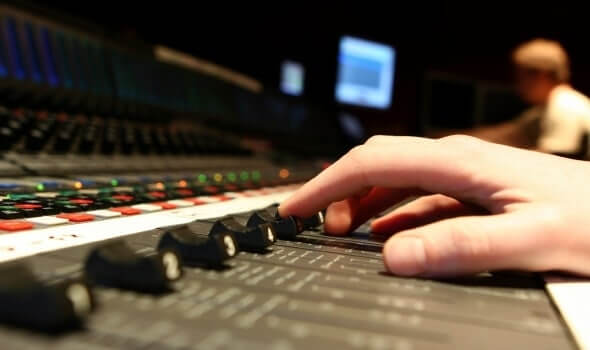
Who Is A Production, Sound Mixer?
The production sound mixer (also called the location sound mixer) is the senior-most sound position during pre-production and production. They serve as a sound recordist during filming, and are responsible for recording and balancing the audio effects on set.
- It’s easy to think of film and television productions as visual mediums, but there’s a significant amount of behind-the-scenes work that goes into an entirely different sensory experience: sound. A key part of any feature film’s sound technicians is the production sound mixer, and they’re a huge part of what makes great sound possible.
What Are The Roles Of A Sound Mixer During The Film Pre-Production Phase?
- Chooses what audio equipment to use for that particular project, as well as providing that equipment.
- Visits the filming locations ahead of time to evaluate any potential sound problems, such as excessive background noise. For example, they evaluate whether there is heavy traffic noise in the area or whether the location is susceptible to high winds.
- Hires or assembles their team, which usually includes boom operators, sound assistants, and sometimes sound trainees.
What Are The Roles Of A Sound Mixer During The Film Production Phase?
- Records sound for the film on set. This includes all actors’ dialogue during every take, as well as “wild sound,” which means any location sounds that the post-production team would want to use in the film or as reference.
- Mixes audio in real-time, which means they balance the volume and other sound quality to ensure the audio will work for the final product.
- Evaluates the quality of the audio after every take and asks for retakes as needed.
- Sets up and takes down all sound equipment.
Who Is A Re-Recording (Dubbing) Mixer?
A re-recording mixer in North America, also known as a dubbing mixer in Europe, is a post-production audio engineer who mixes recorded dialogue, sound effects and music to create the final version of a soundtrack for a feature film, television program, or television advertisement.
- Re–Recording Mixers, work with all the sound elements (dialogue, automated dialogue replacement, Foley, sound effects, atmospheres, and music), and mix them together to create the final soundtrack for a film or television production.
- The final mix must achieve a desired sonic balance between its various elements and must match the director’s or sound designer’s original vision for the project. For material intended for broadcast, the final mix must also comply with all applicable laws governing sound mixing (e.g., the CALM Act in the United States and the EBU R128 loudness protocol in Europe).
- The different names of this profession are both based on the fact that the mixer is not mixing a live performance to a live audience or recording. That is, he or she is re-recording sound already recorded elsewhere after passing it through mixing equipment such as a digital audio workstation and may dub in additional sounds in the process, While mixing can be performed in a recording studio or home office, a full-size mixing stage or dubbing stage is used for feature films intended for release to movie theaters in order to help the mixer envision how the final mix will be heard in such large spaces.
General Overview Of The The Work Of A Re-Recording Mixer
- During production or earlier parts of post-production, sound editors, sound designers, sound engineers, production sound mixers and/or music editors assemble the tracks that become raw materials for the re-recording mixer to work with. Those tracks, in turn, originate with sounds created by professional musicians, singers, actors, or Foley artists.
- The first part of the traditional re-recording process is called the “premix.” In the dialog premix, the re-recording mixer does preliminary processing, including making initial loudness adjustments, cross-fading, and reducing environmental noise or spill that the on-set microphone picked up. In most instances, audio restoration software may be employed. For film or television productions, they may add a temporary/permanent music soundtrack that will have been prepared by the music editor, then the resulting work will be reviewed by test audiences, and then the film or television program is re-cut and the soundtrack must be mixed again. Re-recording mixer may also augment or minimize audience reactions for television programs recorded in front of a studio audience. In some cases, a laugh track may augment these reactions.
- During the “final mix” the re-recording/dubbing mixers, guided by the director or producer, must make creative decisions from moment to moment in each scene about how loud each major sound element (dialog, sound effects, laugh track and music) should be relative to each other. They also modify individual sounds when desired by adjusting their loudness and spectral content and by adding artificial reverberation. They can insert sounds into a three-dimensional space of the listening environment for a variety of venues and release formats: movie theaters, home theater systems, etc. that have stereo and multi-channel (5.1, 7.1, etc.) surround sound systems. Today, films may be mixed in ‘object-based’ audio formats such as Dolby Atmos
- This introduces a heightened atmosphere within the sound field with the introduction of ceiling speakers and the elimination of audio channels.
Why Are Re–Recording Mixers Critical During The Post-Production Phase Of Film Production?
- One of the last steps before a film, television episode or advertisement is released to the public is assembling its soundtrack, a word which, in the industry sense, refers not just to music but to every piece of synchronized audio, including dialogue and effects. This task falls to the re-recording mixer, who takes previously recorded and edited audio elements—the work of production sound teams, dialogue editors, Foley Artists, sound effects editors, composers, music editors, and music supervisors—and layers them together, balancing the levels so that the sound tells a clear and effective story.
- The best re-recording mixers excel in balancing audio so that it enhances the work’s storytelling without distracting from it.
- In many ways, re-recording mixers are the final gatekeepers through which all audio must pass in the film, television, and advertising post-production cycle. Working in two phases—an initial sound mix and a final mix after the material has been shown to test audiences—re-recording mixers attempt to fix any final audio problems that may have slipped under the radar. They cover up any environmental noise, cross-fade between different tracks, apply reverb and other filters and adjust varying audio levels, all in the pursuit of a seamless audio experience.
- While re-recording mixers do their fair share of technical damage control, their most important job is to ensure that the story is told effectively through the sound. This means that every piece of audio is in the right place, demanding the right amount of attention from the audience, and supporting the aesthetic direction of the project as a whole. Taking into account feedback from the supervising sound editor, test audiences, the re-recording mixer must decide when the dialogue should rule the mix when plot-relevant sound effects need to rise above other competing sounds and director.
What Do You Need, To Become A Professional Re-Recording Mixer (Film and TV)
- Career Path
- This is a high-responsibility role that requires impressive credentials. Most re-recording mixers have a bachelor’s or master’s degree in a field like audio production or engineering. They typically must work in several different roles in the world of film/television audio post-production before getting a shot at this one. Often, this means stints as a dialogue editor, effects editor, or music editor. Re-recording mixers who develop a reputation for high-quality work get the opportunity to work on a bigger budget, higher-profile work, or find a full-time position with a Hollywood audio production company.
- Finding Work
- Aspiring mixers should study up on the work of dialogue editors, effects editors, and music editors, as well as gain familiarity with audio storytelling conventions in visual media. Internships and apprenticeships in the field of audio post-production, while difficult to find, are excellent avenues toward this role—although perhaps the best résumé for a beginning re-recording mixer is a number of previous credits on independent, student, and short films. While many jobs are posted openly on traditional job listing websites, networking is a must in Hollywood, and knowing the right person can make all the difference.
- Professional Skills
- Audio production
- Audio engineering
- Audio editing
- Sound design
- Digital audio workstations (DAWs)
- Film knowledge
- Good ears
- Interpersonal Skills
- This is a role in which perfectionism is allowed and even encouraged, as long as it doesn’t stand in the way of timeliness. The best re-recording mixers are usually detail-oriented, focused, humble, and speedy—capable of working self-directed for hours at a time. They are also excellent listeners in both senses of the word: they take direction well and can distinguish subtle nuances in sound. Some say that the highest compliment for a re-recording mixer is when the audience doesn’t notice the mix. This is debatable, but it’s certainly true that top re-recording mixers excel in creating audio that enhances storytelling without distracting from it.
- Work-Life
- Most re-recording mixers are either freelance or employed by audio postproduction houses. Either way, it’s typical to live near the film and television industry in Los Angeles and commute to a film studio’s soundstage when working a job. Sometimes two or more re-recording mixers work together collaboratively or in the presence of a larger creative team, but more often than not, re-recording mixers work alone. Generally, this career entails periods of focused, high-intensity work intermingled with periods of scarcity; achieving a steady workflow is one of the main measures of success.







